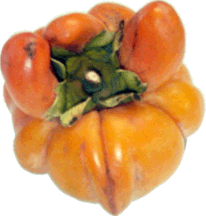 In Time for Thanksgiving, Oriental Persimmons
In Time for Thanksgiving, Oriental Persimmons
Had Captain John Smith eaten oriental persimmons, Diosporus kaki, prior to entering Chesapeake Country, he never would have wasted his time trying to eat our native persimmon Diosporus virginiana. The oriental persimmon is five to 20 times larger than the native persimmon, depending on the variety, which include 15 non-astringent varieties and more than 40 astringent varieties. They generally have few to no seeds.
Here in Chesapeake Country, we can successfully grow approximately six astringent varieties — Sheng, Giboshi, Kyungsun Ban-Si, Sue Shen, and Patapsco — and only two non-astringent varieties — Tan-Kan and Gwangyang. They have survived nearly 20 winters and have produced fruit each year. Some varieties can be picked by simply twisting them from the branches like picking apples while others require the use of small pruning shears.
Many more varieties have been grown in this region, but the winter of 1993 and 1994 killed many of our experimental trees.
The non-astringent varieties can be eaten directly from the tree and do not have any pucker power even when eaten green. But they have the best flavor and crispness when eaten after they have turned orange. Astringent varieties should be ripened soft, like tapioca, before they are eaten. The fruit should only be picked after the skin has turned orange or yellow, depending on the variety.
The astringent fruit will ripen when placed in a warm room. If time is important, ripening can be hastened by placing the fruit in a plastic bag with a red delicious apple or very ripe banana, sealing the bag and storing it in a warm room. Another method of ripening astringent persimmons is to sprinkle them with vodka, gin, bourbon or most any hard liquor before placing them in a plastic bag and storing in a warm room. Whichever bag method you use, it will take approximately five days for the fruit to soften. The skin color will become almost translucent.
Each variety of oriental persimmon has its own characteristic flavor, color and shape. Most of the varieties are very sweet but their flavors vary from mild to strong persimmon flavor. Colors vary from almost lemon yellow to dark orange with some almost reddish orange. The shape of fruits will vary from plum to block-like with four distinct lobes. The size of fruits will also vary from tennis balls to grapefruits.
Oriental persimmons make the ideal backyard fruit tree. They never need to be sprayed because there are no pests in this area that have discovered them yet. Foliage is a lush dark green, and size can easily be controlled by pruning yearly. Because it flowers in late May to early June, it is not bothered by late frost. Its fruit ripens in mid to late October, with some varieties ripening in early November. The variety Patapsco, developed at the University of Maryland, is yellow, plum shaped and late ripening. It stores well in the refrigerator until late January.
Persimmons are easily dried. Cut them in half, string each half on a monofilament fish line with a toothpick tied between each section and hang them in a warm dry room. The fruit will dry to a gummy texture in about two weeks. It is delicious, can be eaten like candy and stores easily.
Francis R. Gouin, UMD professor emeritus, raises peaches and persimmons at Upakrik Farm in Deale.